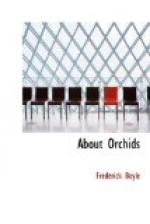Pleasant also it is, by the way, to vindicate the character of green frogs. I never heard them spoken of by gardeners but with contempt. Not only do they persist in escaping; more than that, they decline to catch insects, sitting motionless all day long—pretty, if you like, but useless. The fact is, that all these creatures are nocturnal of habit. Very few men visit their orchid-houses at night, as I do constantly. They would see the frogs active enough then, creeping with wondrous dexterity among the leaves, and springing like a green flash upon their prey. Naturally, therefore, they do not catch thrips or mealy-bug or aphis; these are too small game for the midnight sports-man. Wood-lice, centipedes, above all, cockroaches, those hideous and deadly foes of the orchid, are their victims. All who can keep them safe should have green frogs by the score in every house which they do not fumigate.
I have come to the orchids at last. It follows, indeed, almost of necessity that a man who has travelled much, an enthusiast in horticulture, should drift into that branch as years advance. Modesty would be out of place here. I have had successes, and if it please Heaven, I shall win more. But orchid culture is not to be dealt with at the end of an article.
III.
In the days of my apprenticeship I put up a big greenhouse: unable to manage plants in the open-air, I expected to succeed with them under unnatural conditions! These memories are strung together with the hope of encouraging a forlorn and desperate amateur here or there; and surely that confession will cheer him. However deep his ignorance, it could not possibly be more finished than mine some dozen years ago; and yet I may say, Je suis arrive! What that greenhouse cost, “chilled remembrance shudders” to recall; briefly, six times the amount, at least, which I should find ample now. And it was all wrong when done; not a trace of the original arrangement remains at this time, but there are inherent defects. Nothing throve, of course—except the insects. Mildew seized my roses as fast as I put them in; camellias dropped their buds with rigid punctuality; azaleas were devoured by thrips; “bugs,” mealy and scaly, gathered to the feast; geraniums and pelargoniums grew like giants, but declined to flower. I consulted the local authority who was responsible for the well-being of a dozen gardens in the neighbourhood—an expert with a character to lose, from whom I bought largely. Said he, after a thorough inspection: “This concrete floor holds the water; you must have it swept carefully night and morning.” That worthy man had a large business. His advice was sought by scores of neighbours like myself. And I tell the story as a warning; for he represents no small section of his class. My plants wanted not less but a great deal more water on that villainous concrete floor.




